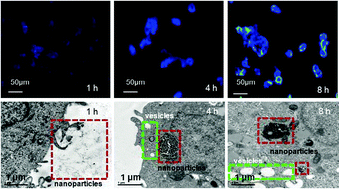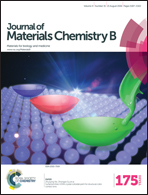Fabrication of hybridized nanoparticles with aggregation-induced emission characteristics and application for cell imaging
Abstract
Fluorescent nanoparticles used to detect important biological events in living cells or animals are in increasing demand in the biological and biomedical fields, and have attracted much attention from chemists and biologists in the past decade. Here, one aggregation-induced emission (AIE) bioconjugate, tetraphenylethene labelled chitosan (TPE-CS), is synthesized, which could be strongly emissive in the solid state. TPE-CS is used as a coating agent for negatively charged hydroxyapatite (HA) nanoparticles, and TPE-CS/HA nanocomposites with positive charges are well dispersed in their aqueous solution with a diameter of 111.9 nm. MTT assay indicates that the fluorescent TPE-CS/HA nanoparticles have good cytocompatibility. 293T cells are imaged by TPE-CS/HA nanoparticles. First, the nanoparticles are adhered to the cell membrane, and then many more particles are endocytosed through phagocytotic vesicles by culturing for a long time, resulting in a much stronger fluorescence emission. TPE-CS/HA bioprobes could strongly bind the cell cytoplasmic region, and might have promising applications in tumor diagnosis, long-term cell tracing, drug metabolism and drug delivery systems.

- This article is part of the themed collection: JMC B Editor’s choice web collection: ‘‘seeing the unseen updated: advances in bioimaging’’

 Please wait while we load your content...
Please wait while we load your content...